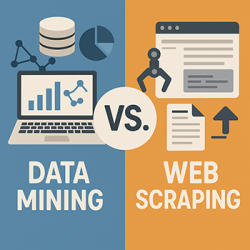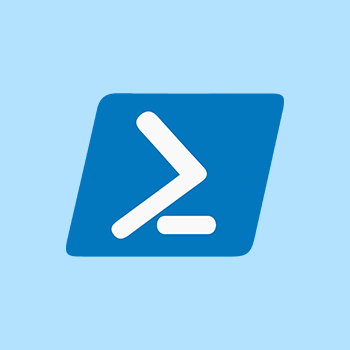Table of Contents
ToggleIntroduction
If you spend time on the Internet, you might have come across the terms data mining and web scraping. They may sound like complicated tech jargon, but don’t worry – they’re easier to understand than you think.
In simple terms, web scraping is like copying or collecting information from websites, while data mining is like analyzing large data sets to find valuable patterns or insights. Think of web scraping as gathering the raw material (data) from the Internet and data mining as examining that material to discover something meaningful. In this beginner-friendly article, we’ll break down data mining vs web scraping in plain English, show how each is used in everyday life and business, discuss their pros and cons, and answer some common questions.
What Is Data Mining?
Data mining examines extensive data collections to discover patterns, trends, or valuable insights. The term mining is used because it’s like digging through a mountain of information to find hidden gems of knowledge. Instead of using a pickaxe, people use computers, statistics, and sometimes Artificial Intelligence algorithms to sift through data automatically.
Simply, data mining tries to make sense of a lot of data. For example, a streaming service like Netflix looks at millions of viewing records to determine what new show you might enjoy. By finding patterns in what many users watch, data mining helps the service make better recommendations. Businesses also use data mining to decide which products to stock or to detect fraud in credit card use. The goal is the same: turn large amounts of raw data into helpful information that people can act on.
What Is Web Scraping?
Web scraping is the process of automatically collecting information from websites on the Internet. It’s like copying and pasting data from a website but done by a computer program (often called a scraper) at a much larger scale and speed. Instead of manually clicking and saving information, a scraper can scan many pages and gather the data for you in seconds.
Simply, web scraping helps you grab publicly available data from websites and put it into a usable format. For example, imagine you want to compare prices for a phone across multiple online stores. You could visit each site and write down the prices or use a web scraping tool to fetch all those prices into one spreadsheet automatically. Similarly, travel websites gather flight or hotel information from various airline and booking sites using scraping to show you the best deals in one place.
Data Mining vs Web Scraping: A Side-by-Side Comparison
Now that we know what each term means, let’s compare data mining vs. web scraping directly. The table below highlights the key differences between them:
| Aspect | Data Mining | Web Scraping |
|---|---|---|
| Purpose/Goal | To analyze large datasets and find patterns, trends, or insights. | To extract or collect data from websites and present it in a structured format. |
| Data Source | Usually databases, spreadsheets, or big data collections (could be from the Internet or anywhere). | Web pages on the Internet (HTML content, public websites). |
| Output/Result | Discoveries, patterns, or actionable insights (e.g. a trend identified, a report, or a model). | A dataset or structured list of the extracted information (e.g. a spreadsheet of prices or names). |
| Example Use | An online retailer analyzes purchase history to recommend new products or detect shopping trends. | A price comparison site collects product prices from multiple online stores automatically. |
As the table shows, web scraping involves data collection and formatting, while data mining involves data analysis and finding meaning in data.
In other words, web scraping gets the data (often from the Internet), and data mining then examines that data for insights. These methods frequently complement each other: you might scrape data from websites first, then use data mining techniques to analyze it and draw conclusions.
How Data Mining Impacts Your Everyday Life
Let’s look at a real-world example. Ever wonder how a streaming service like Netflix seems to know what you’ll want to watch next? It’s not magic – it’s data mining at work. Netflix collects data on what millions of viewers watch and how they interact. Then, using data mining techniques (often powered by Artificial Intelligence), it analyzes that information for patterns. For instance, it might notice that people who watch a specific comedy show also tend to enjoy a particular sitcom. The service suggests other content you’re likely to enjoy using these patterns.
This is just one example. Data mining is used in many industries. Whenever someone has a lot of data and wants to find the meaning behind it, data mining is the tool that turns raw data into insight.
How Web Scraping Is Used Around You
One typical example of web scraping is a price comparison website. Have you seen a site that lists a product’s price across many stores? Those sites use web scraping to automatically visit each store’s page and pull the price information into one list. Instead of a person checking every store, a scraping bot does it in seconds so that you can see all the prices in one place.
More generally, web scraping is used to gather information online. From collecting travel deals and news articles to tracking social media trends, scraping helps whenever we need to collect data from multiple websites quickly. It’s the behind-the-scenes tool that makes many Internet services possible.
Pros and Cons of Data Mining
Like any method, data mining has advantages and challenges. Here are some key ones:
Pros:
- Reveals valuable insights: It can uncover patterns and trends that aren’t obvious, helping businesses make informed decisions (for example, which products sell best in each season).
- Handles huge data sets: Techniques (often aided by Artificial Intelligence) can process far more data than a person, quickly finding value in massive “big data” collections.
- Improves decision-making: It provides data-backed findings, making planning and strategy more fact-based and practical.
Cons:
- Needs good data: The insights are only as good as the data. If data is incomplete or biased, results will be unreliable, and collecting/cleaning enough quality data can take time.
- Complex or costly: Data mining can require specialized software and skills (data experts, powerful computers), which can be a barrier, especially for small teams.
- Privacy concerns: Analyzing personal or sensitive data can be intrusive if done improperly. Companies must follow privacy laws and ethical guidelines when mining data.
Pros and Cons of Web Scraping
Web scraping also has its benefits and drawbacks:
Pros:
- Fast data collection: A scraper program can pull vast amounts of information from the Internet much faster than a person, building big datasets in minutes.
- Saves labor: Once set up, it runs automatically (even 24/7), so you don’t have to gather data by hand. A bot (or AI Agent) does the repetitive work for you.
- Low cost: Many web scraping tools are free or inexpensive, so it’s often cheaper than hiring people to collect data manually.
Cons:
- Fragile if sites change: If a website changes its layout or blocks bots, your scraper might stop working until you adjust it. Also, some sites’ terms of service disallow scraping.
- Data may need cleaning: Scraped data can be messy (with HTML tags or extra text). It often needs to be cleaned and organized before it’s useful for analysis.
- Legal/ethical limits: Scraping not all web data is okay. Some content might be copyrighted or private. Sticking to public information and using scraping responsibly is essential to avoid legal issues.
Frequently Asked Questions (FAQ)
Q: Is web scraping legal?
A: Generally, yes, if you’re accessing public information online. However, it can get complicated. Some websites say that you cannot scrape them in their terms of service. Also, scraping personal data without permission can be illegal or unethical. The bottom line is to stick to public data, respect websites’ rules, and use the data responsibly.
Q: Do I need programming skills for data mining or web scraping?
A: Not necessarily. Some tools let you scrape websites or mine data without coding. For example, some browser extensions can scrape data, and programs like Excel can do essential data mining. However, knowing some programming can help if you want to do more advanced projects. It opens up possibilities (like writing a custom scraper), but you can undoubtedly start without coding.
Q: Can I use data mining and web scraping together?
A: Absolutely. To do data mining on web data, you’ll typically start with web scraping. The two techniques complement each other. If you want to analyze information only available on websites, you first need to collect it (scraping) and then examine it for patterns (mining). Using both in tandem lets you turn raw web data into meaningful insights. So rather than thinking of data mining vs web scraping as an either/or choice, they are often best used hand-in-hand.




